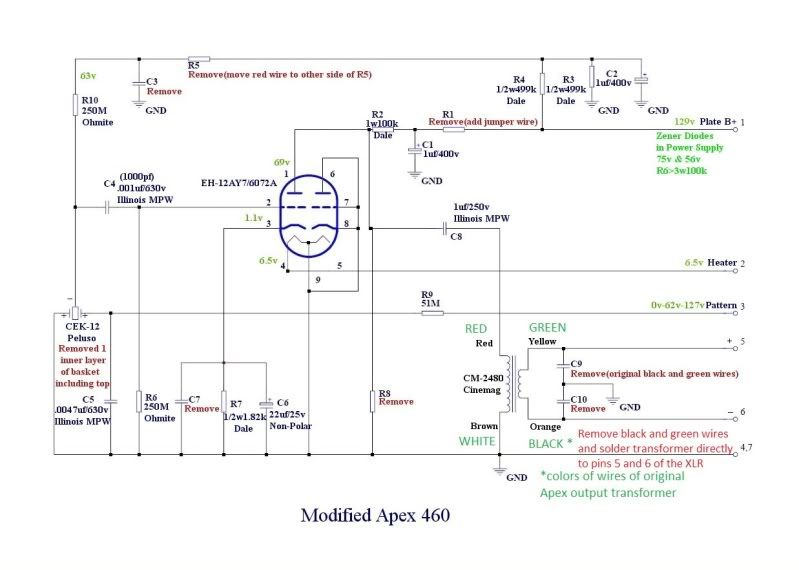It never ends! I don't know if anyone in this thread has mentioned this specific tweak, but, the AKG C12 was fixed bias or so, where the ELA M 251 was cathode biased, like
the Apex 460, with a resistor/bypass capacitor combination, using the typical "common cathode" circuit which I guess is mistakenly referred to sometimes as "plate follower." Which is what you achieve when you rewire the tube socket as described in this thread to remove the cathode follower stage.
Anyway, I wanted to get my mics sounding more C12-ish, so I read around and there's two ways to do it, you can use one of the unused pins, 4 or 7, in the cable to provide a negative voltage from the power supply, which requires cutting tracks and modifying the power supply, JJ Audio Mics uses this method, I have not tried it. I used Brian Fox, from Fox Audio Research, his method of using a diode to control the cathode bias.
You can simply wire up two 1N914 or 1N4148 (these days these are identical, just old names still floating around) in series, with the anodes of the diodes facing ground, and the stripe (cathode) of the diodes facing the tube cathode. This is in place of C6/R7/C7 remove all of those components first. Something about the way diodes conduct gives a fixed bias. You can also use an IR-LED (infrared LED) for the same purpose, Brian Fox claims a slightly softer sound, I'll be trying that next week. Small signal diodes and LEDs are not noisy like Zener diodes, so you don't need to use a bypass capacitor. And in fact, that makes it closer in practice to the C12 schematic. You lose several decibels of output this way, but, it's not a significant loss, just something to be aware of. I haven't experimented with adding back the bypass capacitor to increase gain, because I love the way it sounds now.
With my mic next to its mate, identically built, but with one converted to this "fixed bias," the sound is greatly changed. The cathode bias mic is thicker sounding, heavier in the low end, and sharper in the highs. The "fixed bias" (diode biased) mic is cleaner, cooler, airier sounding with a bit of a scoop. Amazingly like what I guess some of the differences would be between a 251 and a C12! I am convinced that this is a big part of those mics' difference, among other differences documented here:
C12 v. ELA-M251 -- Differences?
The forward voltage of the diode(s) in question is I think the important thing? Somehow 1.5V of voltage drop average, or so, using the data sheet numbers, creates 1.1V on the grid as I measure with my multimeter, which is what you want, which is what the AKG schematic shows.
This is an extremely easy component swap and I would absolutely recommend to give it a shot in your mic and see which direction you want to take it in.
As an added bonus this clears up some physical space for me to cram in my Russian Paper in Oil caps that are coming in the mail for C8...
Think I'm nearing a stopping point with these! And looking forward to some actual recording use.



 schematic posted
schematic posted
